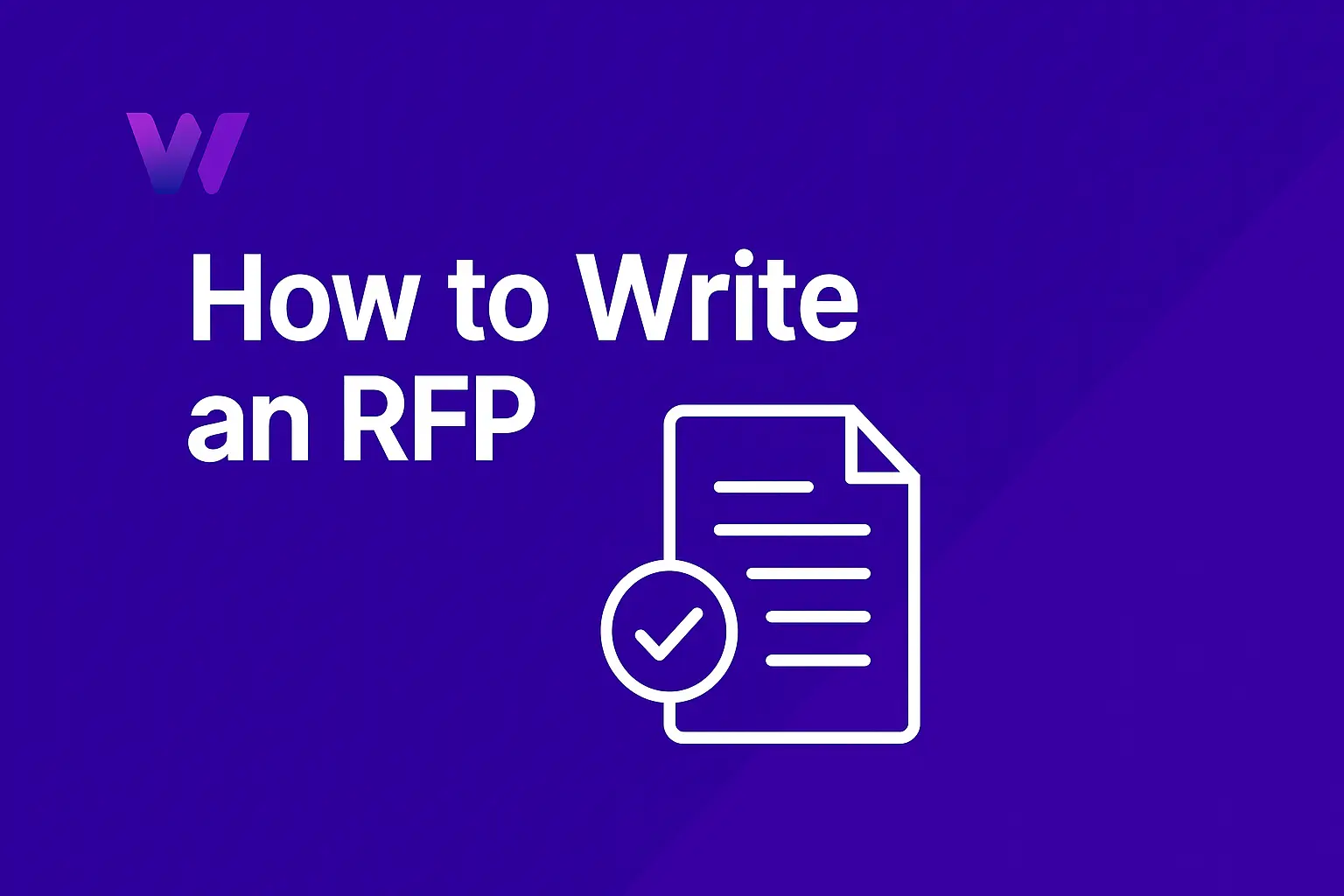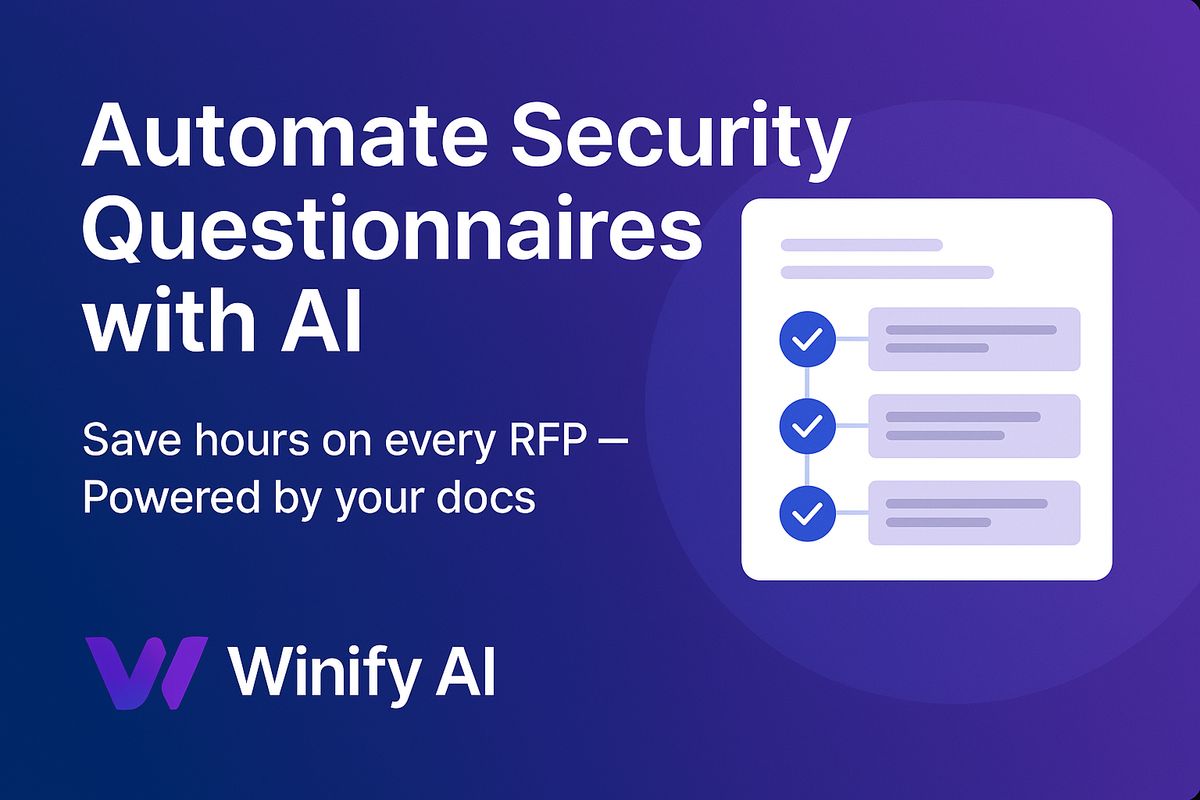· RFP · 4 min read
How to Write an RFP (Free Template & Checklist)
A step-by-step guide to drafting a clear, vendor-friendly Request for Proposal—complete with a downloadable template, scoring matrix, and best‑practice checklist.

TL;DR (60 sec) Download our Word/Google Doc template and scoring‑matrix spreadsheet, “then follow the six expanded steps below to create a vendor‑friendly Request for Proposal (RFP) that gets better responses — faster.”
Introduction
Poorly scoped RFPs attract the wrong vendors, inflate pricing, and trigger month‑long clarification cycles. A clear, outcome‑focused RFP protects your budget and timeline and signals to suppliers that you’re a customer worth prioritising. In the guide below you’ll find a step‑by‑step process, an editable template, real‑world examples, and a checklist to ensure nothing slips through the cracks.
Insight: RFPs with clear scoring criteria receive 3× more complete responses and 25% faster turnaround, according to the Harvard Kennedy School’s Government Performance Lab.
What Is an RFP — and When Do You Need One?
A Request for Proposal (RFP) is a structured document that invites suppliers to propose solutions to a defined business problem. You typically issue an RFP when:
- the contract value exceeds your purchasing threshold;
- multiple vendors could plausibly meet the need;
- price is not the sole decision factor (you must weigh fit, experience, service, etc.).
RFP vs RFI vs RFQ
| Purpose | Typical length | Used when |
|---|---|---|
| RFI (Request for Information) | 1–3 pages | You need a market scan to shape requirements |
| RFQ (Request for Quote) | 2–5 pages | You have a detailed specification and want price only |
| RFP (Request for Proposal) | 8–20 pages + attachment | You want vendors to suggest how they’d solve the problem and at what cost |
Why a well‑written RFP matters
- Faster short‑listing. Structured requirements let you reject mis‑fit suppliers quickly.
- Apples‑to‑apples comparisons. A response template forces vendors into the same format, making scoring simpler.
- Scope control. Clear boundaries stop surprise fees later.
- Negotiation leverage. When bidders see transparent criteria, they sharpen their pencils.
RFPs with clear scoring criteria and structured templates get 3× more complete responses and 25% faster turnaround from vendors.
Step‑by‑Step: How to Write an RFP
1 Define the business problem in one sentence
Outcome over output. Start with the result you need, not the features you think you want.
Example: “We require a SOC 2 automation platform to reduce audit‑prep effort by 40 %.”
Pro‑tip: Write two versions—one for executives (plain language) and one for technical vendors (include metrics).
2 List measurable requirements
Create a two‑column table (Requirement ▸ Must | Should | Nice). Limit yourself to ≤ 25 line‑items—large enough to capture critical needs, small enough that vendors don’t drown in admin.
3 Weight the requirements
Apply a 1–5 weighting to each item so your final evaluation reflects business impact, not vendor sales flair.
| Weight | Meaning |
|---|---|
| 5 | Show‑stopper — bids missing this are disqualified |
| 3 | Important — strong influence on score |
| 1 | Nice‑to‑have |
Pro‑tip: Use our auto‑calculating matrix to avoid spreadsheet errors.
4 Specify budget, timeline & evaluation criteria
Include:
- Target go‑live date (e.g., September 1 2025);
- Contract term (1 + 1 year, evergreen, etc.);
- Evaluation formula (e.g., 60 % fit | 25 % cost | 15 % references).
This transparency filters out vendors who can’t meet your constraints, saving everyone time.
5 Attach a response template
Provide a Word table or spreadsheet with pre‑labelled sections (Executive Summary ▸ Requirements Matrix ▸ Pricing ▸ References). Aligned sections mean reviewers spend time on substance, not format cleanup.
6 Publish, collect & score automatically
Email the RFP to pre‑qualified vendors, set a Q&A deadline, score them using your predefined matrix. (If you’re a vendor responding to RFPs, AI tools can help automate this step.)”
Common RFP mistakes — and how to avoid them
- Laundry‑list requirements. Fix: Limit to 25 critical items.
- Unclear budget. Vendors pad pricing to hedge risk.
- Copy‑paste legal terms. Tailor liabilities to project type.
- No weighting system. Decisions stall when scores are arbitrary.
- Ignoring vendor feedback. Iterate requirements if multiple suppliers point out contradictions.
Why structure matters
According to the Harvard Kennedy School Government Performance Lab, well-structured RFPs with clear evaluation criteria lead to:
- More efficient procurement processes
- Higher-quality proposals
- Better alignment between vendor solutions and project goals
This reinforces why taking time to define requirements, weight them clearly, and include a scoring matrix isn’t just administrative overhead — it’s a strategic advantage.
Free Downloads
Want the RFP template and scoring matrix? Enter your email below and we’ll send you straight to the files.
FAQs
How many pages should an RFP be?
Aim for 8–20 pages plus attachments. Long enough to convey requirements, short enough that vendors can respond in under a week.
Who normally writes an RFP?
Medium‑to‑large organisations delegate drafting to procurement or a cross‑functional project team led by the business owner.
Is there a standard RFP template?
No universal template exists, but most follow this flow: Executive Summary ▸ Requirements ▸ Vendor Instructions ▸ Evaluation Criteria ▸ Legal Terms.
How detailed should requirements be?
Enough to eliminate mis‑fit suppliers but not so prescriptive that you stifle innovative solutions. Use measurable outcomes and leave room for vendor creativity.
What does a successful RFP response look like?
It mirrors your template, answers every requirement, cites evidence, and flags assumptions. The best responses read like solution proposals, not sales brochures.
How long should you give vendors to respond?
Typical windows are 2–4 weeks, depending on complexity. Include calendar dates in the RFP.
Can AI write an RFP?
Yes. New AI tools can now draft requirements and scoring matrices in minutes, then auto‑score incoming proposals.
Next reads
- Security Questionnaires: What they are and how to answer them – seller‑side guide
Written by the WinifyAI Editorial Team
- rfp
- procurement
- vendor management
- template
- compliance

